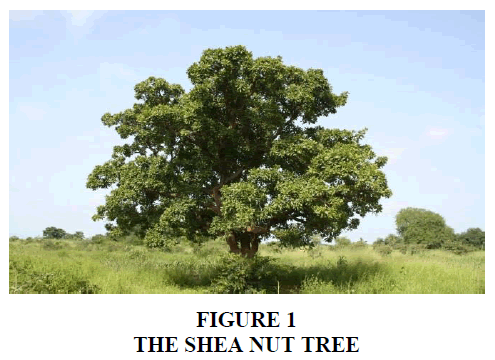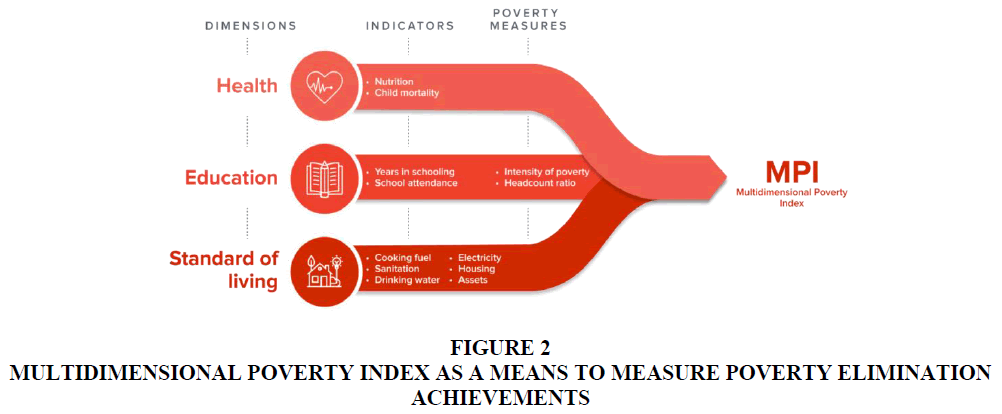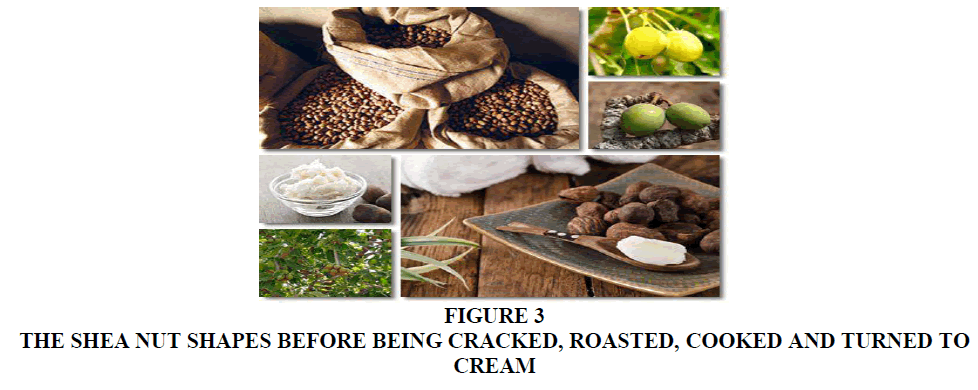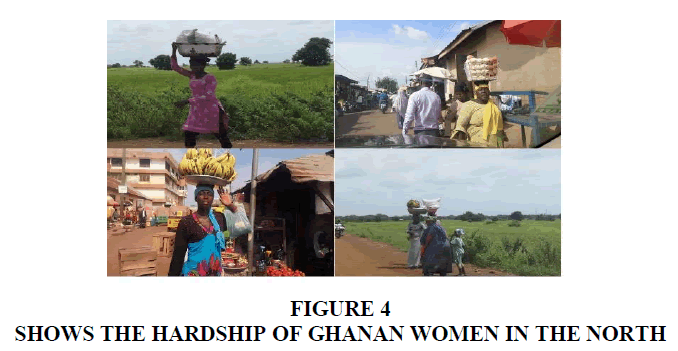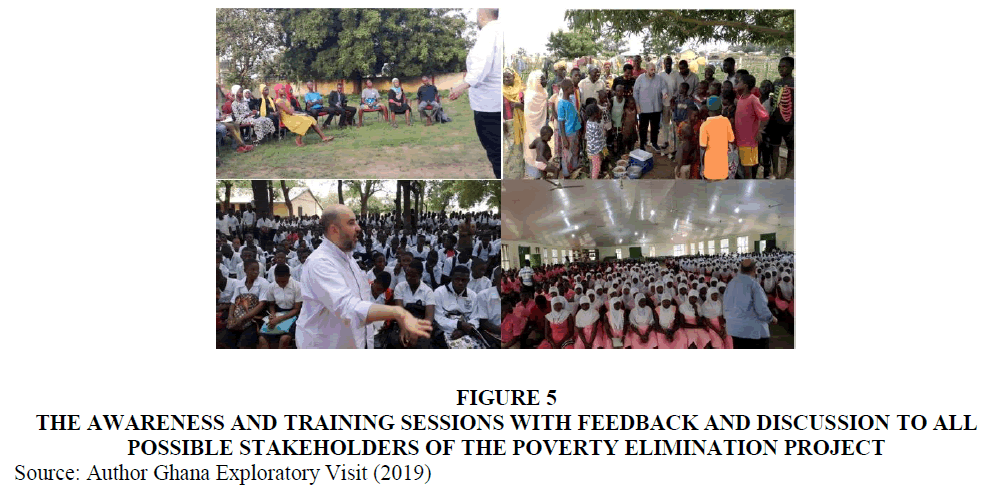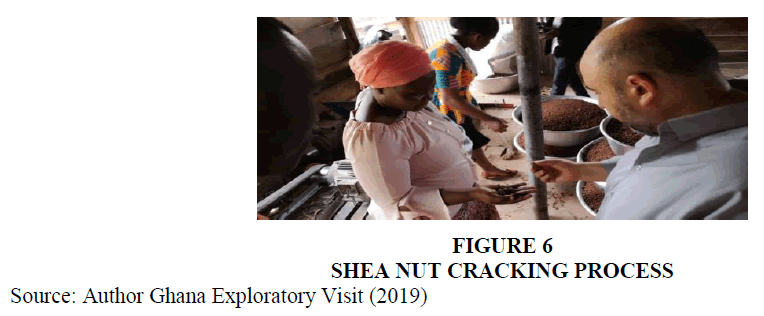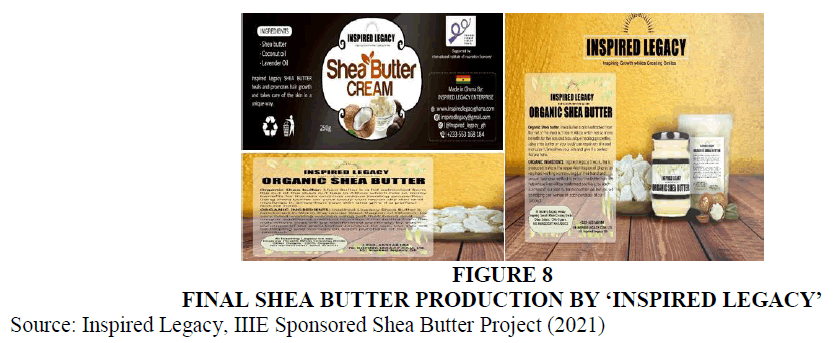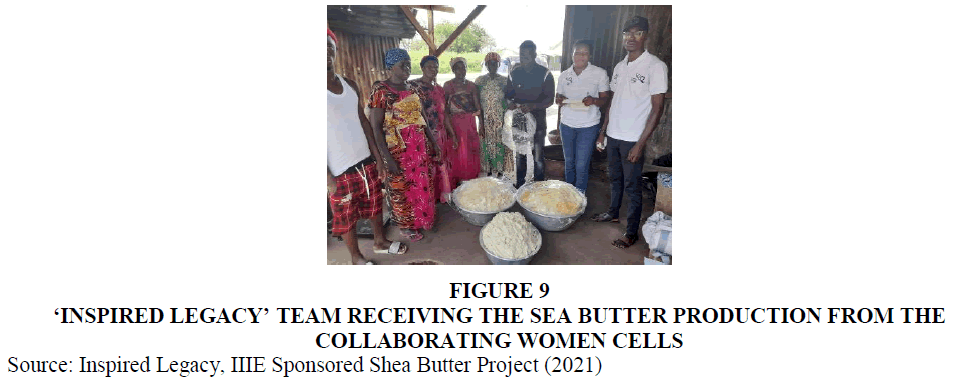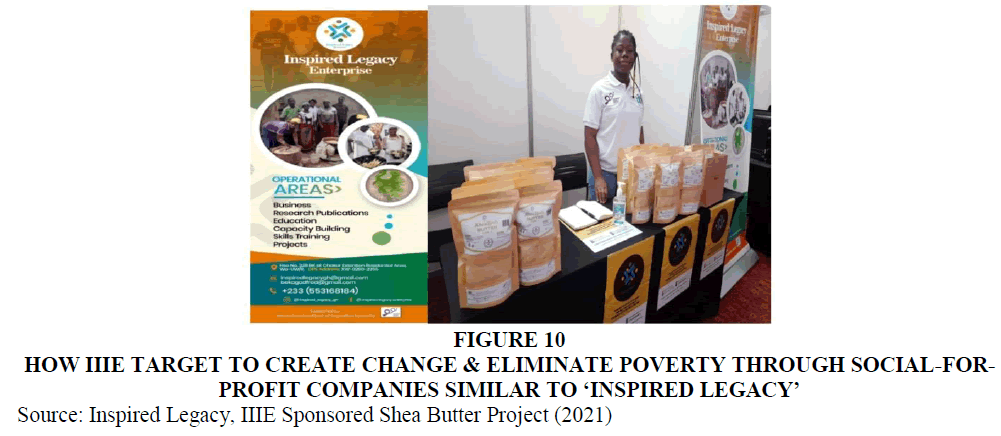Case Reports: 2024 Vol: 25 Issue: 2
Sustaining Poverty Elimination Around the Shea Nut Tree - Case from Ghana
Mohamed Buheji, Socioeconomic Institute for Advanced Studies (SIAS)
Citation Information: Buheji, M. (2024). Sustaining poverty elimination around the shea nut tree - case from ghana. Journal of Economics and Economic Education Research, 25(2), 1-14.
Abstract
This study explores the impact of shea butter production on community development and women's empowerment in northern Ghana, a region where the shea tree is indigenous and its nuts have been traditionally processed into shea butter. The author presents the personal experience of recognising the economic, social, and environmental dimensions of shea-butter production that led to a social-for-profit start-up focused on women's development and how to create similar models in Africa. The project reveals that shea butter production significantly contributes to women's economic empowerment, providing them with a vital source of income, enhancing their financial independence, and elevating their social status within the community. Additionally, the study highlights the role of shea butter production in eliminating poverty. The study underscores the need for targeted interventions supporting poverty elimination that leads to overcoming the multidimensional poverty complexity that is measured through MPI. The study calls for a concerted effort among stakeholders to leverage these indigenous resources for the betterment of communities so that more models can be created for the development of both women and Africa
Keywords
Poverty Elimination, Ghana, Multidimensional Poverty Index (MPI), Women Development, Shea Butter, Africa Development.
Introduction
The Shea nuts are a cash crop obtained from the shea tree. It is found in all the northern parts of Ghana and is one of the businesses doing so well in the international market today. It comes in season and not all year round, which is always during the dry season from March to August. It has a wide range of by-products in two main categories apart from its fruits for feeding. A sample of Shea nuts tree is shown in Figure 1 (Damania, 2009).
Shea nuts include Shea nuts oil used for cooking, shea butter used in making soap, and cosmetics such as moisturisers, salves and lotions. It can also be used in the making of chocolate. Shea nuts are a substitute for cocoa in the north of Ghana. (Hatskevich et al., 2014)
The US Agency for International Development (USAID), and the Global Shea Alliance (GSA), launched the ‘Action for Shea Parklands’ (ASP) initiative in 2020, where 20,000 shea trees were planted across the five northern regions. The initiative seeks to promote, plant, and protect the Shea parklands while advancing a Shea industry commitment to plant 10 million trees across West Africa over the next 10 years. This initiative shows the industry's importance and impact on improving incomes for women and their families and enhancing food security in the region and the world. (AgricToday, 2020; Gyedu-Akoto et al., 2017).
The shea tree (Vitellaria paradoxa), native to the savannah regions of West Africa, provides a resource of immense economic and cultural significance. Among its various products, shea butter stands out for its versatile use in cooking, cosmetics, and traditional medicines. This paper focuses on northern Ghana, where shea butter production is not only a vital economic activity but also a linchpin in the community development narrative and a catalyst for women's empowerment. This activity supports not only their families but also contributes to the broader community welfare. The burgeoning interest in natural and organic beauty and the global demand has the potential to transform local economies and significantly impact the lives of women producers in Ghana.
This paper aims to explore the implications on the lives of a small fund projects on creating models that help Africa to develop through the community development. It seeks to answer critical questions about how this traditional activity fosters economic empowerment, social cohesion, and environmental sustainability.
Literature Review
Understanding the Complexity of Multidimensional Poverty Elimination
Multidimensional Poverty Index (MPI) developed in 2010 by the Oxford Poverty and Human Development Initiative (OPHI) and United Nations Development Programme (UNDP), offers a better understanding of the complexity of poverty, and how to design any targeted intervention, besides monitoring the progress of this intervention effectively (Annim et al., 2020)
As shown in Figure 1, MPI is a composite index that incorporates various dimensions of poverty, including health, education, and living standards. It goes beyond a sole focus on income by simultaneously capturing deprivations experienced by individuals and households across multiple dimensions. By adopting a broader perspective, the MPI aims to provide a comprehensive overview of poverty, emphasising the inter linkages between various aspects of human wellbeing.
To calculate the MPI, a person or household is considered poor if they are deprived in a certain percentage of weighted indicators within each dimension. The weights assigned to different indicators reflect their relative importance. Figure 2 show that the MPI combines three key dimensions: health, education, and living standards. Each dimension comprises several indicators. Health indicators encompass nutrition, child mortality, and access to healthcare. The education dimension examines school attendance, years of schooling, and educational attainment. Living standards also consider indicators like access to clean water, sanitation facilities, electricity, housing, and assets. (Annim et al., 2020)
MPI is very important for generational poverty in regions of Africa where absolute poverty and poverty elimination projects were measured by how many people make more than USD $2.15 a day or so to be above the poverty line. However, eliminating monetary poverty shouldn’t be the goal of any poverty elimination project as it doesn’t reflect people's wellbeing. (MPI, 2023; Buheji, 2022).
Socioeconomic Status of Ghana
Based on World Bank classifications, Ghana transitioned to a lower-middle-income country in 2010. The country's GDP has grown substantially but has not always translated into equitable income distribution. Based on the estimates, about 8 million people (24.6 percent of the population in Ghana) in 2021 are multidimensionally poor. About 6.5 million Ghanaians (20.1 per cent) are classified as vulnerable to multidimensional poverty in 2021. The incidence of poverty (H) in Ghana was 45.6%, while the average intensity (A) was 51.7%.
The Multidimensional Poverty Index (MPI), which is the product of H and A, was 0.236.
In Ghana, more people live in multidimensional poverty (45.6%) than in monetary poverty (23.4%), but 19.3% of the population experiences both monetary and multidimensional poverty. The report indicates that 64.6% of rural populations in Ghana were experiencing multidimensional poverty, compared with 27.0% of urban populations. The Northern Region of Ghana had the highest proportion of multidimensionally poor people at 80% (MPI 2023; Hatskevich et al. 2014).
Ghana Exploratory Visit
The International Institute of Inspiration Economy (IIIE) is a Non-Profit Organisation that works to advance the concepts related to human inspiration development through a series of projects, forums, labs, academic programs, publications, institutions, NGO societies and partners’ centres. The philosophy behind the IIIE models, focuses on engaging the social change leaders with the profound reality of their community opportunities. IIIE usually tries to create experts through learning by exploring. Therefore, a visit to any country or community would start with a program to explore the local community challenges and the non-financial wealth available. The visit is usually arranged by the local team of the community visited (Buheji 2019a).
The theme of IIIE exploratory visits to most African countries focuses on opportunities for poverty elimination projects. i.e. Model projects that can help people start with a limited number of resources, using the non-financial wealth of the community. Usually, most IIIE would start building a model project in the range of USD $1500, paid per the progressive performance of the stakeholders involved. These seed funds are done only after carefully studying the community by the IIIE expert and building trust with the local team who would supervise the project. (Buheji, 2022)
During the exploratory visit, the IIIE expert and the local team would collect close observations on the different socioeconomic issues, then work with them to change the conditions and create sets of possibilities from the broad range of opportunities and cherish it with specific minor resources from within, or with minimal interventions; till the model is created. Then, IIIE encourages the community to replicate the model, or those in power, such as government, semi-government, local, and/or international NGOs. The IIIE usually publishes about this model and ensures the story is shared with the knowledge community (Buheji, 2019b)
In the case of the Ghana visit, a local Team from northern Ghana collaborated with local indigenes and/or the targeted beneficiaries’ group, or a selective type of NGOs to take advantage of the abundance of certain types of natural, or physical wealth and capitalise on it to bring higher profit-margin income for the specific vulnerable group that would be identified during the exploratory visit (Hatskevich et al., 2014)
Poverty among Women in Northern Ghana
Ghana is one of the African countries with a stable emerging economy. The country has been having a steady GDP growth that is above average and steadily climbing in the UNDP Human Development Index (HDI). However, like most African nations, Ghana has a stagnant problem with the multidimensional poverty index (MPI). Most multidimensional poverty occurs outside Akra, the capital of Ghana, especially in the northern provinces. Poverty is also clear among women in Northern Ghana. This may be due to historical and contextual knowledge since women in Northern Ghana face significant economic challenges due to a combination of factors, including limited access to education, agricultural resources, financial services, and cultural practices that may restrict their economic independence. (Hatskevich et al., 2014)
The economy of Northern Ghana is heavily dependent on subsistence agriculture, which is vulnerable to climate change, erratic rainfall patterns, and environmental degradation.
Women, who constitute a significant portion of the agricultural labour force, are particularly affected by these challenges, limiting their income and food security. Cultural and legal barriers often restrict women's access to land and credit, hindering them from engaging in more profitable farming activities or starting their own businesses (Gyedu-Akoto et al. 2017; Hammond et al., 2019).
Efforts to alleviate poverty among women in Northern Ghana must be multi-pronged, addressing both the symptoms and the root causes of their economic and social marginalisation (Hatskevich et al., 2014). Some projects focus on empowering women economically with access to credit, skill training, and market information that can help them engage in more profitable economic activities. Since women are the most suitable members of society to address MPI dimensions, they are the most suitable party to focus on to ensure the targeted type of poverty is gradually and effectively eliminated. i.e. Women would be more capable than men in managing challenges of malnutrition, child safety from mortality, and ensuring the family accessibility to healthcare. In relevance to education, it is also women who care most about the children's school attendance, years of schooling, and educational attainment. Women would also ensure that the family would have clean water, proper sanitation facilities, adequate electricity, housing, and assets. (Hatskevich et al., 2011)
Based on the collective observations by both the IIIE expert and the team, efforts to alleviate or eliminate poverty in the northern region of Ghana often focus on improving women's access to education, healthcare, and economic opportunities, recognising their crucial role in the development and wellbeing of their communities. Therefore, the IIIE methodology in these visits focuses on creating social entrepreneurial jobs for the targeted group, i.e., women in Ghana. (Buheji, 2019c; Hatskevich et al., 2011)
Selecting the Shea Nuts Products Chain
Part of the self-sufficiency approach in any community is to focus on its natural resources and see what type of supply chain and fulfilment it provides. One of the most popular natural products that provide a well-established supply chain is the Shea nuts tree (Laube, 2015). Shea nuts in the northern region of Ghana were selected to be the natural wealth where the projects for eliminating poverty start. Since the shea products (butter, cream, powder, and oil) are produced by unemployed women in the community, IIIE invested in kneaders and roasters to help make the work easier, faster and more productive. Figure 3 gives more details about Shea nuts and its products (Hatskevich et al. 2011; Mushimiyimana & Buheji, 2024; Buheji & Muhorakeye, 2023).
Shea trees grow wild and do not require fertilisers or pesticides, making shea butter production a sustainable option that doesn't harm the environment. This sustainability ensures that future generations can benefit from shea butter production (Damania, 2009).
Honfo et al., (2014) mentioned that the unique nutritional composition and chemical properties of shea products make them very competitive with any other plant. Therefore, there is a growing global demand for natural and organic beauty and cosmetic products. This demand has increased the value of shea butter in the African and international markets. In Africa and for African Americans, Shea butter is heavily used as people are more aware of its benefits for the hair and skin. Big companies that work on beauty and soap production, such as Unilever, are also considered one of the main clients for this product. This demand has opened up new opportunities for Ghanaian women to access the local market, further increasing their potential income (Hammond et al., 2019; Salawu & Ayanda, 2014; Elias & Carney, 2007).
Role of Shea Butter in Community Development and Women's Empowerment in Ghana
The production of shea butter is part of Ghana's tradition. Shea butter has been passed down through generations of women in Ghana. By continuing this tradition, communities preserve their cultural heritage while adapting to modern economic practices. Profits from shea butter production often go back into community development projects, such as building schools, health clinics, and access to clean water. These improvements benefit the entire community and contribute to overall social and economic development.
Women in northern Ghana take a load of hardship and suffer from family instability, due to being responsible for farming and selling products from the field in the local markets, where is usually women would carry heavy items on their heads and walk for about three to ten kilometres per day to sell the items and bring back other food items to create the meal of the day (Figure 4). Therefore, shea butter, often referred to as "women's gold" in Africa, can become a significant source of income and empowerment for many low-income families and women in Ghana (Salawu & Ayanda, 2014). Shea butter production is a major source of income for women in rural communities. The process of harvesting, processing, and selling shea butter provides economic opportunities that were previously unavailable. (Hammond et al., 2019)
Shea Butter Chain in Ghana and its Importance for Poverty Elimination
The Shea Butter Chain in Ghana plays a significant role in the country's economy and has been pivotal in efforts towards poverty elimination, especially in rural and northern parts of Ghana where shea trees are abundant (Laube 2015). Shea butter is produced from the nuts of the shea tree (Vitellaria paradoxa), and it is highly valued for its moisturising properties and as a cooking fat (Hatskevich et al., 2011; Damania, 2009).
Numerous cooperatives, NGOs, and international organisations work with shea butter producers in Ghana to provide training, financial support, and access to markets. This support helps to improve the quality of the shea butter produced and ensures fair trade practices, leading to better prices for the producers.
Overall, shea butter production is a key factor in improving the lives of poor families and women in Ghana, offering a sustainable and profitable way to lift themselves out of poverty, gain independence, and contribute to the development of their communities.
Raising the Profit-Margin of Women in Ghana through Changing the Shea Butter Value Chain
Women gain economic independence and empowerment by participating in the shea butter value chain. With the income from shea butter sales, women can decide household expenses and investments, increasing their role and influence within the household and community. (Laube, 2015).
Profits from shea butter production often go back into local communities, funding community development projects such as schools, health clinics, and water systems. This reinvestment helps improve the overall quality of life for community members.
The shea tree grows naturally in the wild, and its cultivation promotes environmental sustainability, Elias and (Carney, 2007). The trees help prevent soil erosion, improve soil fertility, and contribute to carbon sequestration. Efforts to increase shea production can lead to preserving these trees, an essential part of the Sahel and Savannah ecosystems. (Damania, 2009).
The Market Demand for the Shea Butter
The global demand for shea butter, particularly from the cosmetics industry, has grown significantly. This demand creates an opportunity for Ghana to expand its shea butter exports, contributing to national income and reducing poverty levels. Initiatives to improve the quality of shea butter and streamline the supply chain can further enhance Ghana's competitiveness in the global market. (Laube, 2015).
Despite its potential, the shea butter value chain faces challenges such as low productivity, limited access to markets, and climate change. Support from the government, NGOs, and international organisations are crucial to address these challenges. Initiatives aimed at providing training, improving processing technologies, and facilitating access to markets can help maximise the industry's impact on poverty reduction.
Methodology
This paper works on a methodology that shows how IIEP has selected a Shea Butter social-for-profit project relevant to poverty elimination. Based on the MPI and the necessities for community development and women's development in northern Ghana, this paper used the exploratory visit qualitative approach to create the outcome targeted in this study. The methodology articulates the steps taken to gather the data, the rationale behind the choice of the project chosen, and how these methods contribute to understanding the impact of shea butter production on poverty elimination and at the same time women's development in that region of Africa.
An exploration of the economic, social, and environmental dimensions of shea butter production is also briefly touched upon to capture a comprehensive understanding of the impact of shea butter production.
The semi-structured community engagement settings with key stakeholders, including shea butter producers, local community leaders, and NGO representatives, helped shape the project's outcome. The deep dialogue carried out during the exploratory visit provided an in-depth insight into the challenges and opportunities presented by the shea butter value chain.
The observation from the exploratory visit helped to plan better the shea butter production process and select the suitable community for starting the project.
Application and Analysis
Participatory Planning of Projects that Focus on (Women Development in North Ghana)
The project started with participatory planning where the stakeholders, the women in Northern Ghana or their related NGOs, were engaged. All the stakeholders and community members were met to explain how IIIE projects address the local community needs and leverage local knowledge.
Field observations were used to clearly understand the challenges of the current socioeconomic conditions and identify specific needs and opportunities. As shown in Figure 5 an awareness and training sessions were conducted that also managed to collect feedback and created deep dialogue discussions with all the possible stakeholders of the poverty elimination project.
Figure 5 The Awareness and Training Sessions with Feedback and Discussion to All Possible Stakeholders of the Poverty Elimination Project
Source: Author Ghana Exploratory Visit (2019)
Establishment of RADAR before Creating the Poverty Elimination Model
The first step in creating any MPI-driven poverty elimination is establishing a clear plan for the expected outcome. To achieve this, IIEP uses the RADAR methodology to ensure that the outcome is related to the project capacity, the conditions of the targeted group, the depth, and the impact of the planned project. R means ‘Results’, but IIEP means the ‘Outcome’ expected from the project. At the same time, A means the ‘Approach’ that is going to be used to achieve the outcome. D stands for ‘Deployment’, i.e., how this project will be done and when you can see the outcome. Then, we have the ‘Assess and Review’, the last ‘A’ and ‘R’ of the RADAR.
Applying RADARD to a poverty elimination short-term project that is budgeted not to cost more than USD$ 5000 means that the project might implemented in a specific category of the community, led by a field coordinator who has high ownership of the project and where the outcome can be measured quantitatively not only quantitively. Using the RADAR, the visualised outcome first (R) for this project was to create a social-for-profit initiative that brings together the targeted group, i.e. women in northern Ghana, through exploring and exploiting the non-financial wealth of the north.
The Approach (A) was focused on first finding the type of products available in the north that can be invested in and at the same time of high demand in the market. After studying the type of most suitable products that can be used for low-budget and high-impact model projects, products such as gold and other minerals were excluded. IIIE ended up with one of the following natural products available in northern Ghana: Cocoa beans, Coffee, Cashew nuts, and Shea nuts. Shea nuts were preferred since the last product was abundant and still has a local and international market niche.
The deployment (D) started when IIIE collaborated with a collection of women who produced Shea Butter. The target was to increase the profit span and profit-margin of the women identified. Then finally, the assessment and review were done to see whether the outcome was achieved. Based on the identified project goals IIIE agreed with the social-for-profit coordinator to report every month and/or as and when new seed fund is needed, the project assessment and review (A&R) were defined.
The early seeds fund at the beginning of the project went for registering the company, packaging, labelling, processing equipment and most of all, the registration and approval of the Shea butter material by the Food and Drugs Administration (FDA). The next seed fund is gone for training both the women and the youth that will supervise the quality of produced Shea butter during the various stages of production by the women. Some young interns were trained in sales and marketing of the product types.
The project emphasised community engagement and capacity building, thus actively involving local communities in the implementation process to build ownership and ensure the sustainability of development efforts. During the pilot community, real-time data was gathered about the project's feasibility, challenges, and immediate and long-term impacts.
Outcome of the Exploratory Assessment Visit
Based on the feedback loop of the exploratory visit, formal mechanisms for integrating the lessons learned from monitoring and evaluating the different possible project value chains during the exploratory visit, and specific objectives were set to foster a culture of learning and adaptation within the social-for-profit company. The company was called the ‘Inspired Legacy’ following the other projects that IIIE have established and is targeting to create a major impact that creates a further legacy.
The visualisation was focused on a project that aims to enhance the economic opportunities for vulnerable people, such as the women of northern Ghana. Therefore, learning cycles are adopted as part of the ‘inspired legacy’ so that the initiative stays focused on environmental conservation and sustainable resource use. The project also focuses on best practices for community-based natural resource management (Figure 6).
Establishment of ‘Inspired Legacy’ Shea Butter Company
Ghana is one of the leading suppliers of shea butter in shea nuts, which Is a global demand for cosmetic purposes. Shea Butter is derived from the shea tree, which is very common in the north of Ghana, mainly in rural areas where poverty and other socioeconomic problems are common. In northern Ghana, most women engage in the shea butter production business to earn an income.
Inspiration economy projects in Ghana saw that Sea Butter could be an avenue that could be used to solve some of the socioeconomic problems common in the Northern sector of Ghana. Therefore, IIIE started a company called ‘Inspired Legacy’. The role of inspired legacy in causing social change is to serve as a ready market for women who produce shea butter. IIIE, through ‘inspired legacy’ would also be working on establishing relations with other countries to buy shea butter directly from the Women who produce them.
The ‘inspired legacy’ project, buys up to 100kg of shea nuts bags with every production plan. Then, the company ensures the women start a hygienic butter processing using the local method. Also, the ‘inspired legacy’ has secured constant buyers who patronise the developed butter with added organics and ingredients to add value for cosmetic purposes for hair and skin. Now, the company also has customers from other countries who buy in bulk. Through ‘inspired legacy’, IIIE has served as a ready market for women involved in producing shea butter and palm oil. More than 200 women are now constantly supplying the shea butter, and this helping them to enhance their profit margin. Figures 7 & Figure 8 illustrate the ‘inspired legacy’ complete production process till the packaging and marketing stage.
Figure 7 The Process of Recruiting Women to Join the Shea Nut Tree Production Till the Final Production of Butter or Powder
Source: Inspired Legacy, IIIE Sponsored Shea Butter Project (2021)
Figure 8 Final Shea Butter Production by ‘Inspired Legacy’
Source: Inspired Legacy, IIIE Sponsored Shea Butter Project (2021)
Challenges for Sustaining the Outcome of Poverty Elimination Projects Similar to Inspired Legacy
Many projects aim to secure funds to eliminate poverty for a specific region or specific group of targeted beneficiaries. Getting funds can be considered the easiest part of the story; the challenge is keeping the mediator focused on the socioeconomic development and not ending up with just another entrepreneurial project that utilises the community to make more profit. This might work for many, but there is no evidence so far that this double standard has managed to really bring people out of poverty, especially since poverty, as we all know is a complex problem that needs close monitoring by data and follow-up, which most business entrepreneurs would fail to do (Figure 9).
Figure 9 ‘Inspired Legacy’ Team Receiving the Sea Butter Production from the Collaborating Women Cells
Source: Inspired Legacy, IIIE Sponsored Shea Butter Project (2021)
The other challenge for such a project is that the strong company usually completes it and might need an investment of more than ten thousand dollars to compete internationally. This, again, would take the project away from the idea of being self-sufficient. However, this can be overcome if one considers that these threats can make us strive to establish more women's groups to diversify the type of shea butter products and create more innovation in the supply chain. Skills development, education and training need to continue along with engagement for graduate women to support the development of the supply chain and meeting food and safety international standard. (Mushimiyimana & Buheji 2024).
The other minor challenges that need to be maintained are website development and updates leading to digital trading on all social media platforms. The biographic and digital records of all volunteers, members, and stakeholders should constantly be updated. The production and distribution process must be monitored consistently until they reach the proper place in the most suitable shops within and outside Ghana. Challenges of exports to outside Ghana emphasise the need for a strong network within the supply chain (Figure 10).
Figure 10 How Iiie Target to Create Change & Eliminate Poverty Through Social-for- Profit Companies Similar to ‘Inspired Legacy’
Source: Inspired Legacy, IIIE Sponsored Shea Butter Project (2021)
Discussion and Conclusion
The Significance of contribution of shea butter production to the economic empowerment of women in northern Ghana
This paper highlights the significant contribution of shea butter production to the economic empowerment of women in northern Ghana and shows the importance of non-financial wealth in eliminating the complexity of poverty. Such natural resources increase income levels, financial independence, and the ability to contribute to household and community needs, and help the beneficiaries go beyond the MPI requirements.
Shea butter chain in Ghana is more than just an economic activity; it is a lifeline for many families, particularly women, in rural areas. It offers a sustainable way to combat poverty, empower women, and promote community development. With the proper support and investments, the shea butter industry can significantly contribute to poverty elimination and economic development in Ghana.
For the paper on the role of shea butter in community development and women's empowerment in northern Ghana, the conclusion should encapsulate the main findings, their implications for policy and practice, and recommendations for future research. The paper also shows the social implications of a natural resource as the shea butter value chain, including improved social status for women, more robust community ties, and the role of women as key players in sustainable development.
Implications and Limitations
One has to acknowledge the study's potential limitations, such as the limitation of the sample's representativeness, and response bias to convenient sampling happening during the training engagement program and on the exploratory visit, besides the limitations associated with the interpretive nature of qualitative data. Further studies can help organise focus group discussions with women shea butter producers to explore their experiences, challenges faced, and the perceived impact of shea butter production on their lives and communities.
One of the implications of this study is that it briefly outlines the expected approach or contributions to initiate a poverty elimination program with minimal resources. Also, this paper shows the role of women's development in poverty elimination and sustainable community development based on meeting the requirements of MPI. This study could also provide practical insight for policymakers, NGOs, and other stakeholders engaged or involved with poverty elimination projects currently or in the future.
The other implication of the sustainability of shea butter production is its role in promoting environmental conservation through preserving shea parklands. Future research that focuses on the challenges faced by women in the shea butter production chain, such as market access, and climate change, is also recommended.
Recommendation for Future Studies
This paper suggests areas for future research, such as longitudinal studies to track the long-term impact of shea butter production on communities, comparative studies with other regions or products, and in-depth value chain analyses to identify further opportunities for women's empowerment.
References
AgricToday (2020) U.S. supports Shea Parkland Restoration Initiative and women’s economic empowerment, August 13
Buheji, M. (2019). Poverty labs-from ‘alleviation’to ‘elimination and then prevention’ . Journal of Social Science Studies, 6(2), 108-122.
Buheji, M. (2019). Re-defining Our Approaches to Extreme Poverty: An Attempt to Disrupting Contemporary Poverty Alleviation Approaches through Inspiration Economy Project-A Case Study . International Journal of Economics and Financial Issues, 9(4), 80.
Indexed at, Google Scholar, Cross Ref
Buheji, M. (2019). Shaping Future Type of Poverty-The Foresight of Future Socio-economic Problems & Solutions-Taking Poverty as a Context-Beyond 2030. American Journal of Economics, 9(3), 106-117.
Buheji, M. (2019). Social Innovation and Sustainable Entrepreneurship. Am. J. Econ, 9, 154-156.
Indexed at, Google Scholar, Cross Ref
Buheji, M. (2022). Reporting Extreme Poverty Elimination Model from Sub-Saharan Africa–A Case Study of Two Years Journey from Mauritania. International Journal of Management (IJM), 13(8), 2022.
Indexed at, Google Scholar, Cross Ref
Damania, A. B. (2009). The Shea Nut Tree (Vitellaria paradoxa)-Empowering Women Against Poverty in Developing Economies. Asian Agri-History, 13(1).
Elias, M., & Carney, J. (2007). African shea butter: A feminized subsidy from nature. Africa, 77(1), 37-62.
Indexed at, Google Scholar, Cross Ref
Gyedu-Akoto, E., Amon-Armah, F., & Yabani, D. (2017). Utilization of shea fruit to enhance food security and reduce poverty in Ghana. African Journal of Science, Technology, Innovation and Development, 9(6), 697-705.
Indexed at, Google Scholar, Cross Ref
Hammond, J., van Wijk, M., Pagella, T., Carpena, P., Skirrow, T., & Dauncey, V. (2019). Shea butter: a pro-poor, pro-female route to increased income. The Climate-Smart Agriculture Papers: Investigating the Business of a Productive, Resilient and Low Emission Future, 215-226.
Indexed at, Google Scholar, Cross Ref
Hatskevich, A., Jenicek, V., & Darkwah, S. A. (2011). Shea industry–a means of poverty reduction in Northern Ghana. Agricultura Tropica et Subtropica, 44(4), 223-228.
Hatskevich, A., Srnec, K., & Essilfie, J. E. (2014). Shea butter processing as an engine of poverty reduction in Northern Ghana: Case study of four communities in the Bolgatanga Municipality. African Journal of Agricultural Research, 9(43), 3185-3190.
Indexed at, Google Scholar, Cross Ref
Honfo, F. G., Akissoe, N., Linnemann, A. R., Soumanou, M., & Van Boekel, M. A. (2014). Nutritional composition of shea products and chemical properties of shea butter: a review. Critical reviews in food science and nutrition, 54(5), 673-686.
Indexed at, Google Scholar, Cross Ref
Laube, W. (2015). Global shea nut commodity chains and poverty eradication in northern Ghana: myth or reality?.
Mensah, F., Agyaho, J. F., Kofinti, R. E., & Sebu, J. (2020). Multidimensional Poverty-Ghana. Ghana Statistical Service.
MPI (2023) A Comprehensive Assessment of Poverty Beyond Monetary Measures, Multidimensional Poverty Index, UI News Desk13 July 2023.
Mushimiyimana, E., & Buheji, M. (2024). Rwanda’s Self-Sufficiency Journey-Analysis of Achievements, Challenges, and Way-Forward in The Context of Sub-Saharan Africa. International Journal of Management (IJM), 15(1), 43-66.
Salawu, O. L., & Ayanda, I. F. (2014). Assessment of the contribution of shea butter processing to poverty reduction among women in Kwara State, Nigeria. Journal of sustainable Development in Africa, 16(3), 1-12.
Received: 04-Mar -2024, Manuscript No. jeeer-24-14569; Editor assigned: 05-Mar-2024, Pre QC No. jeeer-24-14569 (PQ); Reviewed: 10-Mar-2024, QC No. jeeer-24-14569; Revised: 16 -Mar -2024, Manuscript No. jeeer-24-14569 (R); Published: 24- Mar-2024
